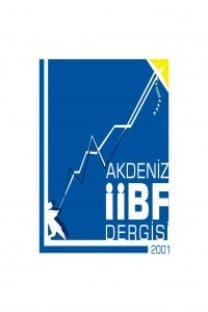Türkiye’de Konut Sektörü, Ticari Hizmetler ve Kamu Hizmetlerinin CO2 Emisyonlarının 1990 - 2017 Dönemi için İncelenmesi
The Examination of CO2 Emissions in Residential Buildings, Commercial and Public Services over 1990 – 2017: A Case Study for Turkey
CO2 emissions;, residential sector;, commercial and public services;, environment; sustainability,
___
- Akbostancı, E., Türüt-Aşık, S., & Tunç, G. İ. (2009). A decomposition analysis of CO2 emissions from energy use: Turkish case. Energy Policy, 37, 4689-4699.
- Akbostancı, E., Türüt-Aşık, S., & Tunç, G. İ. (2011). CO2 emissions of Turkish manufacturing industry: A decomposition analysis. Applied Energy, 88, 2273-2278.
- Akın, G. (2006). Küresel Isınma, Nedenleri ve Sonuçları. Ankara Üniversitesi Dil ve Tarih-Coğrafya Fakültesi Dergisi, 46 (2), 29-43.
- Ang, B.W. (2004). Decomposition analysis for policymaking in energy: which is the preferred method? Energy Policy, 32 (9), 1131-1139.
- Appenzerler, T. & Dimick, R. D. (2004). “Dünya Alarm Veriyor.” National Geographic, Eylül 2004.
- Boyd, G., McDonald, J., Ross, M., Hansont, D., (1987). Separating the changing composition of US manufacturing production from energy efficiency improvements: a Divisia index approach. The Energy Journal 8 (2), 77–96.
- Bozoğlu, B., Keskin, B., & Çavdar, S. (2003). Küresel Isınma. Çevre Sorunları Öğrenci Yaklaşımları Sempozyumu, Nisan 2003 – Mersin.
- Dünya Bankası (2020). Dünya Kalkınma Göstergeleri. https://databank.worldbank.org/home.aspx (Erişim tarihi: Eylül 2020).
- Ersoy, Ş. (2006). Küremiz Isınıyor. Bilim ve Ütopya, 139, 5-13.
- Hatzigeorgiou, E., Polatidis, H., Haralambopoulos, D., (2008). CO2 emissions in Greece for 1990–2002: a decomposition analysis and comparison of results using the Arithmetic Mean Divisia Index and Logarithmic Mean Divisia Index techniques. Energy 33 (3), 492–499.
- Işık, M., Sarica, K., & Ari, I. (2020). Driving forces of Turkey’s transportation sector CO2 emissions: An LMDI approach. Transport Policy, 97, 210-219.
- Karakaya, E., Bostan, A., & Özçağ, M. (2019). Decomposition and decoupling analysis of energy-related carbon emissions in Turkey. Environmental Science and Pollution Research, 26, 32080-32091.
- Kumbaroğlu, G. (2011). A sectoral decomposition analysis of Turkish CO2 emissions over 1990 – 2017. Energy, 36, 2419-2433.
- Lise, W. (2006). Decomposition of CO2 emissions over 1980-2003 in Turkey, Energy Policy, 34 1841-1852.
- Marques, A. C., Leal, P. A., Fuinhas, J. A. (2019). Decoupling economic growth from CO2 emissions: Decomposition analysis by sectoral factors for Australia. Economic Analysis and Policy, 62, 12-26.
- Rüstemoğlu, H. (2016). Ekonomik Büyümenin Çevresel Maliyeti: Türkiye ve İran Ölçeğinde CO2 Emisyonlarının Belirleyicileri. İnsan ve Toplum Bilimleri Araştırmaları Dergisi, 5(7), 2151-2168.
- Rüstemoğlu, H. (2019). Factors affecting Germany’s green development over 1990-2015: A comprehensive environmental analysis. Environmental Science and Pollution Research, 26 (7), 6636-6651.
- Shahiduzzaman, M., Alam, K. (2013). Changes in energy efficiency in Australia: A decomposition of aggregate energy intensity using logarithmic mean Divisia approach. Energy Policy, 56, 341-351.
- Streimikiene, D., Mardani, A., Cavallaro, F., Loganathan, N., & Khoshnoudi, M. Carbon dioxide (CO2) emissions and economic growth: A systematic review of two decades of research from 1995 to 2017. Science of the Total Environment, 649, 31-49.
- Tornqvist, L., Vartia, P., Vartia, Y.O., (1985). How should relative changes be measured? American Statistician, 43–46.
- Uluslararası Enerji Ajansı (International Energy Agency – IEA) (2020). https://www.iea.org/data-and-statistics?country=WORLD&fuel=Energy%20supply&indicator=TPESbySource. Erişim tarihi: Eylül, 2020
- ISSN: 1302-9975
- Başlangıç: 2001
- Yayıncı: Akdeniz Üniversitesi
İngiltere'nin Suriye’ye Yönelik Dış Politikası
Amerikan Dış Politikasında Jeopolitiğin Önemi
Suriye İç Savaşına Machiavelli Üzerinden Bakmak
Pınar KAYA SAMUT, Hasan ADIGÜZEL
Osmanlı İmparatorluğu’nda Celali İsyanları: Chayanovyan Bakış Açısıyla Bir Değerlendirme
Miraç Savaş TURHAN, Ali DANIŞMAN
BM Kolektif Güvenlik Sisteminin Etkinliği Sorunu: Realist Bir Değerlendirme
